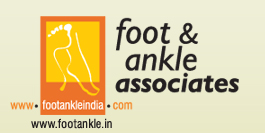

 |

| Treatment of Arthritis of The Heel Joint (The Subtalar Joint) |
Arthritis of the heel joint
will lead to pain in the outside of the ankle, and stiffness of
the back of the foot. Walking on uneven ground surfaces is difficult
since the inversion and eversion movement of the subtalar joint
is missing. The treatments can consist of anti-inflammatory medication,
injection of the subtalar joint with cortisone, special arch supports
and heel cushions, and surgery. We have reported in the literature
that when surgery is necessary to correct the problem, that the
longer it takes to perform this surgery after a fracture of the
calcaneus, the longer it will take to return the individual back
to a more normal lifestyle, in particular heavy work. There are
many different types of surgery which can be performed, and this
is determined by the severity of the deformity, the presence of
arthritis, and other problems such as tearing of tendons, pain in
the ankle, and widening of the heel. |
 |
The heel in the picture
on the left is severely deformed following a fracture of the calcaneus
which was not treated with surgery. The heel bone is flattened and
collapsed. Look at the picture of the calcaneus on the right, where
the arch and the height of the heel is normal. This picture on the
right is of a patient who also sustained a fracture of the calcaneus,
but although arthritis of the joint occurred, there was minimal
deformity present. When the deformity of the heel is not severe, and there is minor arthritis, then all that may need to be done is to remove the excess bone under the outside of the ankle. The problem here is called impingement where bone from the broken calcaneus rubs on the under side of the ankle causing pain. |
 |
In these pictures, this is
an operation to remove excess bone on the outside of the heel after
a calcaneus fracture. You cannot see the heel joint (subtalar joint)
on the left picture. After removal of the excess bone, it is now
possible to see the white grisel surface of the top of the subtalar
joint. The long white structure is the peroneal tendon which was
caught and stuck as a result of the extra bone on the side of the
heel. |
 |
This picture is a CAT scan
of the back of the heel. The very irregular surface represents the
arthritis of the subtalar joint. The treatment for this condition
is to fuse or glue together the joint surfaces to eliminate the
arthritis and decrease pain. This operation is called a subtalar
fusion. |
 |
This is a typical picture of arthritis and
minor deformity of the heel following fracture of the calcaneus.
It has been corrected with an arthrodesis (fusion) of the subtalar
joint with screws. When the deformity of the heel is more severe, a fusion of the subtalar joint is not sufficient, and a piece of bone (called a bone graft) is place into the joint to restore the more normal dimension of the heel. In both of these pictures the deformity of the heel is severe, and the heel is very flat. The height of the heel must be restored, and this can be done with a fusion of the subtalar joint, but a block of bone graft must be used for this surgery. |
 |
In the picture on the left, the heel has been
opened, and a piece of bone is used from the bone bank. It is never
necessary to use bone from your pelvis for this type of surgery.
On the right hand picture, two screws have been used and it is easy
to see the difference in the shape of the heel compared to the pictures
above. |
 |
The picture on the left is of a patient who
had been treated with surgery five times after a fracture of the
calcaneus. A fusion of the subtalar joint had been attempted without
success, and the screw that had been used to secure the fusion is
loose. The foot is very deformed and flat. This is extremely difficult
surgery, which was done as shown on the picture on the right hand
side, with repeat fusion using bone graft and multiple screws. It
is easy to see the improved shape and position of the heel in the
picture on the right hand side. |
| ©
Foot & Ankle Associates. All Rights Reserved. |
Website Powered
by : Sterling Softwares |